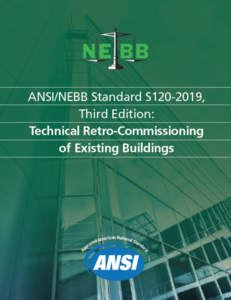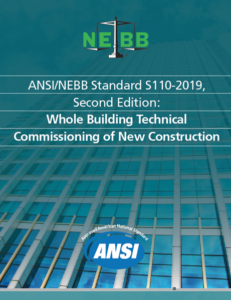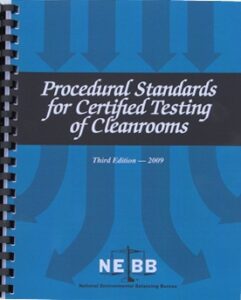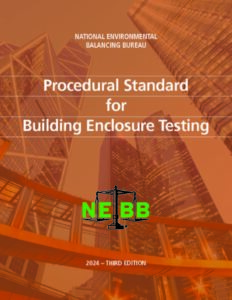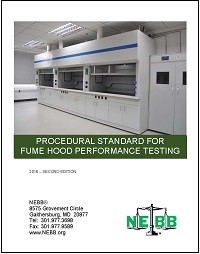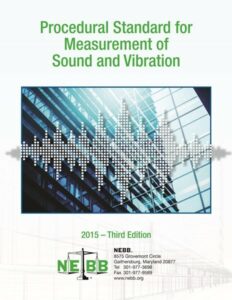NEBB Procedural Standards
Improve building performance and maintain on-site excellence with NEBB’s procedural standards.
Keep current with the latest NEBB Procedural Standards below:
ANSI & NEBB Procedural Standards
Technical Retro-Commissioning of Existing Buildings
ANSI/NEBB Standard S120-2019, Third Edition
Technical Retro-Commissioning (RCx) is the process of inspecting, testing, analyzing adjusting and optimizing existing building system to meet the owner’s needs. This publication is ideal not only for those working in the RCx industry but also building owners and managers who wish to understand the minimum acceptable work that should be undertaken for a successful RCx project.
Features of the publication include:
- Required RCx Processes, Procedures, and Documentation
- Identification of dynamisms for an RCx Process
- Technical RCx process and deliverables overview
- Step-by-step compendium of existing building optimization for the professional
- Informative guide to developing a proper RCx report
- Guide to quick fixes vs. deferred maintenance corrections
- Analyzation of issues
- Corrective actions recommendations
- Performance Testing and Evaluation
- Continuous Performance Tracking
An American National Standard is a document that has been sponsored by an ANSI-accredited standards developing organization (SDO) and then approved by ANSI’s Board of Standards Review (BSR) as meeting certain criteria for openness, balance, due process, and consensus in standards development. ANSI’s SDO accreditation and American National Standard approval processes work in tandem to help make standards development in the U.S. an equitable and open process that serves both U.S. business and the public good.
Whole Building Technical Commissioning of New Construction
ANSI/NEBB Standard S110-2019, Second Edition
Technical Commissioning (Cx) is the creation, implementation and documentation of a commissioning process that involves third party technical inspections and systems testing performed and documented by the Commissioning professional and his team.
The NEBB Certified Professional (CP) acting as an advocate for the owner utilizes the processes of this standard to support the designers, contractors and operators in delivering a fully functional building for all the systems included in the project commissioning scope. A key component of Technical Commissioning is that the CP is responsible to identify issues and conditions that do not meet the project requirements as defined by the OPR and supports the project and design teams in the identification of issue resolution. The CP tracks these issues until all issues are resolved as described in this standard.
Technical Commissioning goes beyond the contractor quality process of the standard commissioning process in providing system testing of system operation and functionality. Whereas the standard contractor quality process depends upon the installing contractors to assess the quality and operability of the systems they install, the technical commissioning process uses third party inspection and testing of those systems to validate operability and functionality of the systems.
Technical Commissioning is also different than the standard commissioning process in that technical commissioning does not utilize sampling strategies for Mechanical, Electrical, and Plumbing (MEP) equipment and system testing but actually requires functional testing on all MEP components for 100% tested systems, as described in this standard.
Building owners are entitled to a professional service from their commissioning professional on every project. To this end, commissioning should be performed by highly trained individuals who are employed by a certified firm and have demonstrated their capability by receiving a personal certification in commissioning. NEBB certifies firms and provides certification of qualified individuals in building systems commissioning. Using NEBB certified firms and individuals in the performance of commissioning to this standard assures the owner of a high-quality project.
The purpose of this standard is to identify the minimum acceptable efforts for a Whole Building Technical Commissioning Project.
An American National Standard is a document that has been sponsored by an ANSI-accredited standards developing organization (SDO) and then approved by ANSI’s Board of Standards Review (BSR) as meeting certain criteria for openness, balance, due process, and consensus in standards development. ANSI’s SDO accreditation and American National Standard approval processes work in tandem to help make standards development in the U.S. an equitable and open process that serves both U.S. business and the public good.
NEBB Procedural Standards
Procedural Standard for Certified Testing of Cleanrooms
THIRD EDITION – 2009
The purpose of the NEBB Procedural Standards for Certified Testing of Cleanrooms is to establish a uniform and systematic set of criteria for the performance of cleanroom testing and certification.
Today’s buildings provide highly controlled indoor environments. This is especially true when dealing with clean environmental conditions required by today’s micro-electronics, bio-medical, and other highly technical industries. These conditions could not exist without sophisticated mechanical systems created by a team of skilled professionals. A key member of this team is the NEBB Certified Cleanroom Performance Testing (CPT) Firm.
This Third Edition represents a departure from past editions. All of the material devoted to Cleanroom Fundamentals, contamination theory and practice, and various testing application data has been intentionally omitted from this edition for two reasons. First, all of this material currently exists in the NEBB Cleanroom Home Study Course and secondly, that type of material is not normally presented in a published standard. This Procedural Standard presents the functional requirements of the NEBB Cleanroom program and the testing and reporting requirements only. This edition is divided into two distinct Parts: Standards and Procedures. These CPT procedural standards have been developed using language defined by “Shall, Should, and May” as it relates to the standards and procedures described in this manual. It is important to note these particular words throughout this manual and how they pertain to the NEBB standards and procedures.
These standards and procedures are intended as the minimum NEBB requirements that a NEBB Certified CPT Firm shall follow when performing Cleanroom Testing and Certification procedures. Contract document requirements or contractual agreements between the Owner and the NEBB Certified CPT Firm may supersede the NEBB requirements. These Procedural Standards have been carefully compiled and reviewed by the NEBB Technical Committees.
Part 1 STANDARDS
Part 1, STANDARDS, covers the requirements for Quality Control and Compliance, Instrumentation Requirements, and CPT Reports. Revised requirements for CPT instruments and reports are identified. The new report requirements allow the NEBB Certified CPT Firm more flexibility in designing their reports by prescribing sets of information that “Shall, Should and/or May” be required to complete a CPT Report.
Part 2 PROCEDURES
Part 2, PROCEDURES, covers measurement procedures of the various testing requirements for
cleanroom testing and certification.
APPENDICES
The Appendices include a suggested CPT Specification, References, and Engineering Equations. This Third Edition of the CPT Procedural Standards, when used by NEBB Certified CPT Firms, will assure the building owner or operator that facility systems have been properly tested within design and installation limitations.
Procedural Standard for Building Enclosure Testing
THIRD EDITION – 2024
The purpose of the NEBB Procedural Standards for Building Enclosure Testing is to establish a uniform and systematic set of criteria for the testing and commissioning of building enclosure systems. This publication is the second edition of the BET Procedural Standard. Similar to the other NEBB disciplines, the Procedural Standard serves as the anchor for the program. There are several standards that define building enclosure testing such as ASTM E779 Air Leakage Testing and ASTM E1827 Building Airtightness.
Additionally ASTM E 1186 defines the Standard for thermography. These publications define the testing procedures to be used when performing BET and are well recognized and respected in this area of expertise. The NEBB discipline builds on these standards and complements them by providing a program combining the testing requirements with a complete package for firm and professional certification.
The NEBB Procedural Standard and the NEBB Building Enclosure Testing (BET) program define the requirements for certification of the firm, for certification of the professional, for educational and experience requirements, for reporting consistencies, and for instrumentation requirements.
This Procedural Standard is similar to other NEBB Procedural Standards in that it is divided into two distinct Parts: Standard and Procedures.
This Procedural Standard is intended to be the minimum NEBB requirement a NEBB BET Certified Firm. When performing testing of building enclosure systems and reporting the results contract documents may supersede the NEBB requirements. This BET Procedural Standard has been carefully compiled and reviewed by the NEBB Technical Committees.
The NEBB Procedural Standards and the NEBB Building Enclosure Testing (BET) program define the requirements for certification of the firm, for certification of the professional, for educational and experience requirements, for reporting consistencies, and for instrumentation requirements.
This Procedural Standards is similar to other NEBB Procedural Standards in that it is divided into two distinct Parts: Standards and Procedures. These standards and procedures are intended as the minimum NEBB requirements a NEBB BET Certified Firm follows when performing testing of building enclosure systems and reporting the results. Contract documents may supersede the NEBB requirements. These BET Procedural Standards have been carefully compiled and reviewed by the NEBB Technical Committees.
Part 1. STANDARDS
Part 1, STANDARD, covers the requirements for Quality Control and Compliance, Responsibilities, Instrumen-tation Requirements and BET Reports. The report requirements allow the NEBB Certified Firm more flexibility in designing reports by prescribing sets of information required to complete a BET Report.
Part 2. PROCEDURES
Part 2, PROCEDURES, covers required Safety Requirements and an Overview of Testing Requirements to be followed when using this Procedural Standard.
Part 3. APPENDICES
The APPENDICES are normative and informative. They include a suggested NEBB BET specification, sample calculations, illustrations, references, engineering formulas, definitions, and instruments.
This edition of the BET Procedural Standard, when used by a NEBB BET Certified Firm, assures the building own-er of standard accurate reporting of Building Enclosure Testing.
Procedural Standard for Fumehood Performance Testing
2016, Second Edition
The purpose of the NEBB Procedural Standard for Fume Hood Performance Testing is to establish a uniform and systematic set of criteria for the performance testing of fume hoods.
This publication is the second edition of the Procedural Standard. Similar to the other NEBB disciplines, the Procedural Standard serves as the anchor for the program. Fume hoods and other safety control environments, such as bio-safety cabinets, offer a distinct set of challenges to the firms and individuals testing the field performance of these specialized containment enclosures.
The American Society of Heating, Refrigerating, and Air-Conditioning Engineers (ASHRAE) has developed an ANSI/ASHRAE Standard 110 Method of Testing Performance of Laboratory Fume Hoods. Another standard is ANSI/AIHA Standard Z9.5 Laboratory Ventilation. These publications define the testing procedures to be used when testing fume hoods and are well recognized and respected in this area of expertise. The NEBB discipline builds on these standards and complements them by providing a program that combines their testing requirements with a complete package for firm certification.
The NEBB Procedural Standard and the NEBB Fume Hood Certification Program define the requirements for Firm Certification, Certified Professional qualifications, educational, and experience requirements, as well as reporting and instrumentation requirements.
This second edition represents an update from the past edition and remains divided into two distinct Parts: Standards and Procedures. This Procedural Standard has been developed using language defined by “Required” (Minimum Requirements) as it relates to the standards and procedures described in this manual.
These standards and procedures are intended as the minimum NEBB requirements that a CF must follow when performing FHT procedures. Contract documents supersede the NEBB requirements. This FHT Procedural Standard has been carefully compiled and reviewed by the NEBB FHT Committee.
Part 1. STANDARDS
Part 1 covers the Definitions, as well as requirements for Quality Control and Compliance, Instrumentation Requirements and FHT Reports. The report requirements allow the CF flexibility in designing their reports by defining sets of information that is required to complete the NEBB Certified FHT Report.
Part 2. PROCEDURES
Part 2 covers Health and Safety, Laboratory and Cleanroom Protocol, Overview of Testing Requirements and the required Testing Procedures.
Part 3. APPENDICES
The Appendices includes recommendations, suggested NEBB FHT specification, test illustrations, ejector specifications, references and engineering formulas.
Procedural Standard for Measurement of Sound and Vibration
THIRD EDITION (September 2015)
The purpose of the NEBB Procedural Standard for Measurement of Sound and Vibration is to establish a uniform and systematic set of criteria for the performance of the sound and vibration testing of environmental and building operations.
Today’s buildings provide highly controlled indoor environments. These conditions could not exist without sophisticated mechanical systems created by a team of skilled professionals. A key member of this team is the NEBB Certified Sound and Vibration (S&V) Firm.
This publication is identified as the “Third Edition”. In fact, this is the fourth Procedural Standard that NEBB has produced for the Sound and Vibration program. The first publication (1977) focused on the measurement and reporting of sound and vibration levels. The second publication (1994) added the dimension of assessment to the S&V firm’s responsibility. The third publication (2006) returned the focus of the discipline back to its foundation; measurement and reporting of S&V data and was published as the Second Edition.
These standards and procedures are intended as the minimum NEBB requirements that a NEBB Certified S&V Firm shall follow when performing sound and vibration measurements and reporting the results. Contract documents may supersede the NEBB requirements.
Part 1 STANDARDS
Part 1, STANDARDS, covers the requirements for Quality Control and Compliance, Instrumentation Requirements, and S&V Reports. Revised requirements for sound and vibration instrumentation and reports are identified.
Part 2 PROCEDURES
Part 2, PROCEDURES, covers measurement procedures of sound and vibration testing for building systems.
APPENDICES
The Appendices includes both long and short form of suggested NEBB S&V specifications, and sample report forms.
This edition of the S&V Procedural Standard, when used by NEBB Certified S&V Firms, will assure the building owner of standard accurate reporting of sound and vibration levels for their facilities.
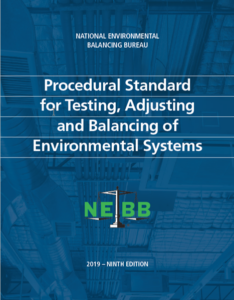
NINTH EDITION- 2019
The NEBB Procedural Standard for Testing Adjusting and Balancing of Environmental Systems (Procedural Standard) establishes a uniform and systematic set of criteria for the performance of the testing, adjusting and balancing of environmental or Heating, Ventilating and Air-Conditioning (HVAC) systems.
Today’s buildings provide highly controlled, sustainable energy efficient indoor environments. These buildings include very sophisticated mechanical systems created by a team of skilled professionals. A key member of this team is the NEBB Certified Testing, Adjusting and Balancing (TAB) Firm (CF). This standard and these procedures are intended as the minimum NEBB requirements that a NEBB Certified Firm must follow when performing TAB procedures. When contract documents do not specify details for Testing, Adjusting and Balancing, this procedural standard becomes the minimum standard to which a NEBB Certified TAB Report must meet. Conversely, contract documents may include more stringent requirements as necessary, in which NEBB Firms must meet this standard plus any additional, more stringent, requirements as dictated by the contract documents.
This Procedural Standard has been carefully compiled and reviewed by the NEBB TAB Committee.
